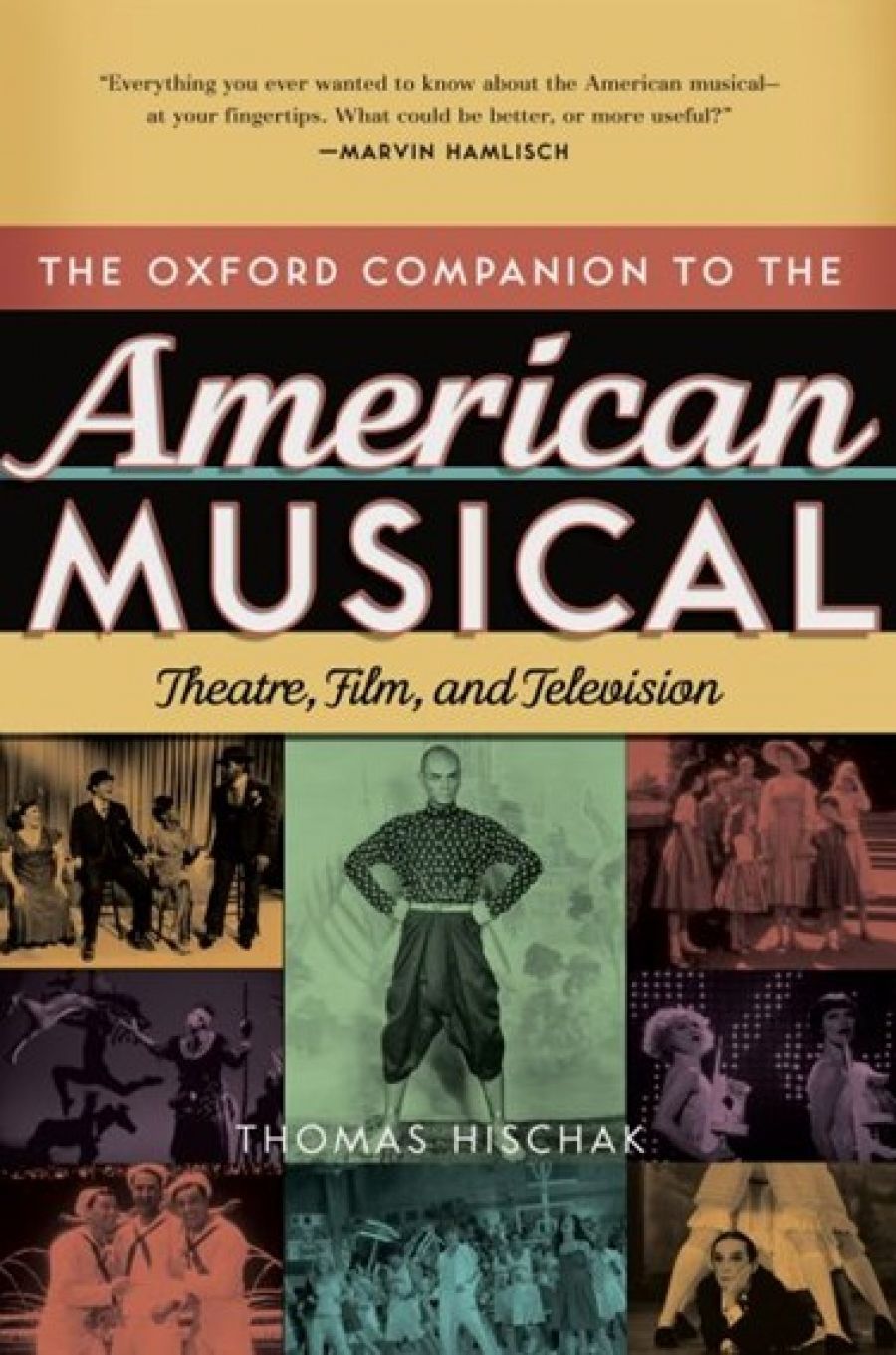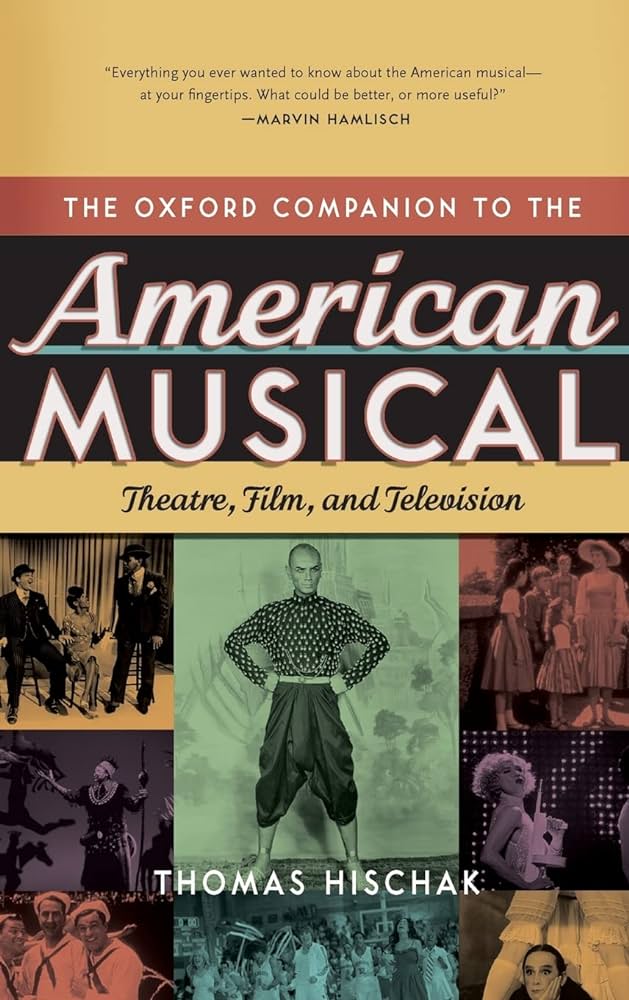
- Free Article: No
- Contents Category: Theatre
- Custom Article Title: ‘Not tonight, paleface’
- Review Article: Yes
- Article Title: ‘Not tonight, paleface’
- Online Only: No
- Custom Highlight Text:
With 827 pages of entries on individual performers, shows, composers, lyricists, directors and choreographers, together with almost another hundred pages of appendices covering the chronology of musicals, guides to recordings and awards, a bibliography and an index, this compilation is an impressive volume to appear under the name of a sole author. Thomas Hischak has already published more than a dozen works on various aspects of the American musical, and the present study is as comprehensive and many-sided as the genre itself.
- Book 1 Title: The Oxford Companion to the American Musical
- Book 1 Subtitle: Theatre, film and television
- Book 1 Biblio: OUP, $79.95 hb, 923 pp
- Book 1 Cover Small (400 x 600):

- Book 1 Cover (800 x 1200):

These days, such companions, guides or encyclopedias tend to be the work of a collective, under the judicious editorship of a distinguished scholar; but there are definite advantages if the roles of editor, researcher, critic and scholar are combined in one. Hischak can write as evocatively and smartly on The Black Crook from 1866 – ‘the most talked about feature of [the show] was the scantily clad chorines who showed more leg than previously seen outside of ballet’ – as he can on Dirty Rotten Scoundrels from 2005: ‘this show was so polished and well acted that few realized or cared that it was paper thin and sophomoric to boot.’
He can provide illuminating details on topics ranging from Frontier Musicals to Opera Singers in Musicals; from the contribution made by the stage music arranger (as distinct from orchestrator) Trude Rittman to shows such as The King and I and My Fair Lady, to the double career of Howard Dietz, who, as well as being a brilliant lyricist (primarily with Arthur Schwartz: think such gems as Dancing in the Dark and That’s Entertainment), was also an executive at MGM, in charge of publicity for over thirty years.
Along the way, the author displays a nice line in versions of the quip modest: Moulin Rouge prompts the observation that the musical numbers ‘all seemed to explode on the screen, causing some viewers to declare [it] the most innovative, exciting musical in decades, and others to run out of the theatre in panic’ (frankly, I was there desperately trying to outrun the other lemmings); while Randel Kleiser’s contribution to the cinema version of Grease is accurately described as ‘[directing] without feeling for the period or much else’. And few would disagree with his assessment of Richard Attenborough’s lumpen film version of A Chorus Line: ‘the movie that couldn’t be made became the movie that shouldn’t have been made.’
On the other hand, some of his observations tend towards the facile or plain wrong-headed. I have always been happily immune to the toothy ‘charms’, harsh voice and even more grating personality of Carol Channing, but for Hischak, this ‘big-eyed blonde comedienne is one of the most distinctive talents in the American theatre’. Barbra Streisand’s exercise in musical monomania, Yentl, is seen not only as a ‘powerhouse directing debut’ in which ‘she shone as producer, co-author and star’, but also as ‘one of the most visually beautiful movies of the decade’. A saner and more measured view of Streisand is provided by the ever-reliable off-Broadway satirical cabaret Forbidden Broadway, where she is hymned as ‘beyond over-indulgent’; while the film itself usually figures high on lists of all-time turkeys.
More disconcerting, however, are some of the abbreviated characterisations of particular composers and works, along with some stylistic solecisms which range from the odd to the semi-illiterate. In the case of the former, the British production team for Mamma Mia would be slightly put out to learn that it was an Australian musical; and it is surely inaccurate to describe the (unarguably gifted) and imaginative director–choreographer Gower Champion (1920–80) as ‘perhaps the last in the line of Busby Berkeley-like artists who instinctively knew how to provide dazzling entertainment values in all that he touched’. Few would dispute the aptness of the latter part of the sentence. But I should have thought most scholars would want to make a case for Michael Kidd (1919–2007) or Michael Bennett (1943–87) as equally deserving of the Berkeley comparison.
And when it comes to summarising the genius of Ernst Lubitsch in terms of ‘the frothy Lubitsch touch’, one can only shake one’s head at the author’s seeming insensitivity to the edgy and ironic skewering of social and sexual mores that characterises such masterpieces as Angel or To Be Or Not To Be. Admittedly, Hischak points out that Lubitsch was responsible for ‘satires about love, sex and money’: but the Lubitsch touch is deft, urbane, witty and light – never frothy.
As for some of the vagaries of expression and style: one wonders what OUP New York is doing these days for editors and proofreaders. How else to explain such gems as the following: ‘The Wild Party was unrelentless in its nightmarish style’; ‘Although little remembered today, [Ralph Blane’s] songs “Have Yourself a Merry Little Christmas” and “The Trolley Song” are still familiar standards’; or ‘D’Oyly Carte favourite Martyn Green … reprised his risible performance in this … film’ [the 1939 Mikado]? The unfortunate Blane even gets a second serve in the entry on his collaborator Hugh Martin, with the final sentence: ‘Their most popular songs remain “Have Yourself a Merry Little Christmas”’. As a summary of one’s career, this ranks with Stephen Sondheim’s own (ironic) comment to audiences (‘I’d now like to introduce a medley of my hit’) before slipping into the opening bars of ‘Send in The Clowns’. And while Leopold Stokowksi’s career was notable for its longevity, it would probably head the entries in the Deity’s Guinness Book of Records if it had in fact run from 1822–1977, along with the remarkable regressive run of Cabaret (1997–1098).
Such howlers are not worthy either of OUP or of the book itself, whose merits and usefulness far outweigh such egregious errors. It is a book for dipping into, a great research tool, as lyricist Lynn Ahrens notes, and a compendium of comment, anecdote and factual detail on that most vital and heterogeneous art form, the musical. No lover of the form would want to be without a volume which, along with everything else, includes a breathtaking photograph of the young Barbara Cook, a memorable shot of Bob Hope in bed with an unfamiliar partner (a horse), whose somnolent expression clearly indicates ‘not tonight Paleface’, and an entry on the Englishman Reginald Gardner, among whose variety turns were the ability to impersonate trains and – wallpaper.


Comments powered by CComment